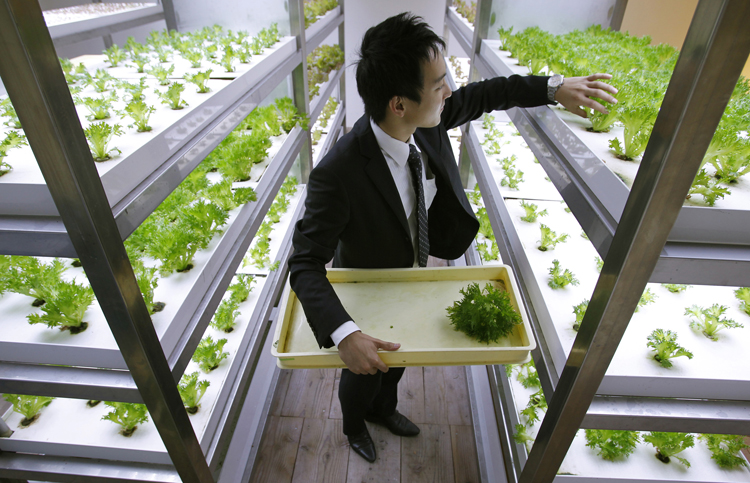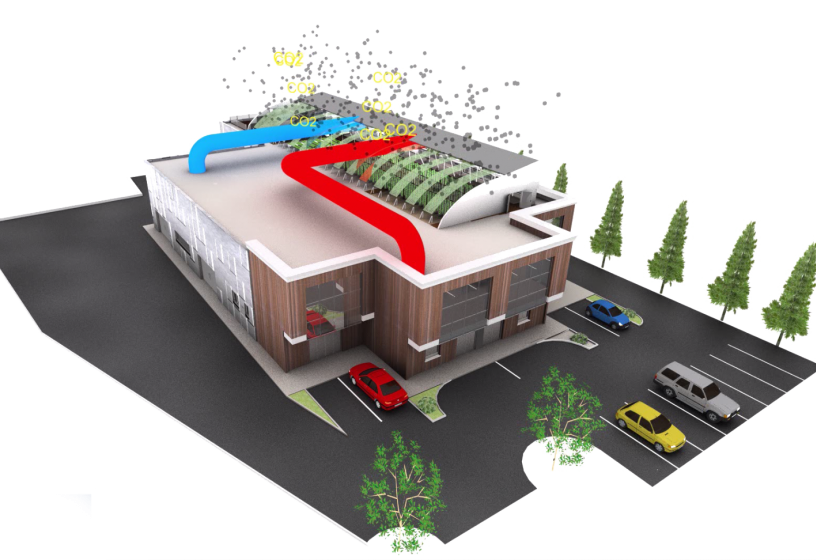Corporate Gardens
When companies reconnect with nature…

Solutions are growing in cities, literally. They are part of the answer to multifaceted challenges: skyrocketing urbanisation trending towards 70% of urban residents by 2050, ever so urgent environmental challenges, structural setback of employment, as well as food security and resilience. They take the form of urban vegetable gardens and green spaces, intertwine short circuits, citizen engagement and the latest technologies… The central idea is the same: exiting the dichotomy opposing productive countryside to consuming cities by relocating production into urban areas, reconciling producers and consumers. But how can companies play their part in this new green wave? Employee wellbeing, energy savings or even additional sources of revenues… the benefits of corporate gardening span far and wide. Dive into a green exploration.
Farms in the heart of cities, fruit and vegetables growing on companies’ rooftops… These projects are being successfully implemented and go beyond mere utopian ideas.
Wellies and gloves for employees: toward blooming office spaces?
Timberland has its Victory Garden; Google, Facebook, SEB, EDF have created their vegetable gardens. Across the world, the idea blooms. Luxembourg isn’t immune to it either, and projects are seeing the light, such as at IFSB in Bettembourg, AG2R in Bertrange and Pall Center in Oberpallen…
In a day and age where chronic stress is becoming a major preoccupation for corporations, they have turned to gardening, to the greater satisfaction of their employees. The Japanese company Pasona, pioneer in this field, stands out with its full-fledged urban farm in the heart of Tokyo. Their employees are actively involved in the harvesting and can enjoy the fruit of their labour straight in their plates. Such an environment is conducive to productivity, concentration and creativity. According to The Economics of Biophilla, a work environment connected to nature improves employee performance and can decrease absenteeism rates by 10%. Additionally, it creates ties between colleagues, regardless of hierarchical positions and fosters collaboration. A true organisational innovation indeed. You shall thus not be surprised to see gardening make its way onto human resource directors’ agendas, since wellbeing has become a key topic within corporations. In the face of growing demand, solutions are arising: gardens are indoor as much as outdoors; sometimes full office spaces even turn alfresco.
From traditional to high tech
Shovel and shears, or connected greenhouse? The scope of methods is very broad according to the very objective of the gardens. From smaller pots favouring a good atmosphere between colleagues to vertical urban farms, there is a whole world of possibilities. Since 2012, in Singapore, the very innovative Sky Greens project has opened the way for automated solutions with yields 10 times bigger than traditional cultivation models. An ambition which has been adopted (and adapted) by office environments. Indeed, the Plantagon tower, a multifunctional and completely automated 17 story building – of which half are dedicated to subsistence agriculture – was recently imagined in Sweden. Their objective? To feed 5000 people thanks to this new half-office, half-farm concept.
If high end technology has the potential to reconcile cities with agriculture, it is also declined at much smaller scales. It is indeed also the solution to small, distributed, automated systems widely available, thus offering the possibility of a transversal urban food production system. The latter usually rely on less resource-intensive cultivation techniques, such as hydroponic, aquaponic or aeroponic installations.

Green Offices of Pasona in Tokyo.
Positive impacts on the environment
Cities are more vulnerable to climate change than their rural neighbours. By 2100, it is anticipated that they will experience temperatures 8° warmer, on average. Artificial microclimates saw the light through the combined effects of intensified human activity and ground coatings fostering greater absorption rates of solar calories. These urban heat islands require adaptation strategies. We are now talking about bio-climatizing cities by influencing two variables: albedo and evapotranspiration. Urban gardens clearly fit into this approach. The Secretary of State Camille Gira reiterated it during IMS’s conference on this topic: “Corporate Gardening is part of climate mitigation.
We need to get away from decoration greening to useful gardens”. Thanks to the reintroduction of vegetation, a better absorption of rainwater can actively limit flood risk. Certain types of installations can also contribute to the thermal regulation of buildings and benefit from their fatal heat and CO2 to feed plants in a circular greenhouse model. These green initiatives in companies are also urban biodiversity refuges. Some grow forgotten vegetables, others set up nesting boxes and beehives. This aligns with an ongoing dynamic in Luxembourg. On January 13th, 2017, the country reiterated its priorities and the 28 measures of its National Plan 2017-21 regarding the protection of nature. Amongst others, it highlights the importance of taking action: “this biodiversity has been declining for over forty years, be it in terms of species, habitats or ecosystems, and especially so in wetland and agricultural land ecosystems. Overall, the situation of biodiversity and ecosystems in Luxembourg is no better than that of the European Union’s other member states.”
Finally, at a time where a quarter of global road freight is associated with the agribusiness, urban gardens respond to the need to promote shorter circuits. And it is hard to imagine a shorter circuit than the one travelled by a salad grown on a company’s rooftop and consumed in its restaurant a few floors down. A particularly urging necessity for Luxembourg, which imports 96% of its fruits and vegetables.

Toward a new economic model?
The phenomenon is growing rapidly and becoming a great opportunity for corporations to harness. The idea? Massifying the process, entering an economic logic of production able to reinforce the resilience of cities.
From then on, a new outlook is cast on buildings. Companies’ flat rooftops and other cultivatable surfaces, widely ignored to this day, become potentially interesting capital. Too far from corporate core business? Alternatives exist, such as leasing services which allow for agricultural installations to be exploited by professionals. Better still, these models are inclusive and plan to, in the long run, enable the hiring and training of vulnerable workers.
You said positive environmental, social and economic impact? This convergence is the very definition of sustainable development. This model has a future. In the Grand-Duchy, corporate rooftops could cover up to 20% of the needs in fruit and leaf vegetables in 10 to 15 years! Today, Luxembourg is betting on this unexploited opportunity and just launched a study to define a national urban gardening strategy. This systematized approach, if translated appropriately, could position the country as a true pioneer in this field. An ambition whose growth we will follow closely.
-Article published on June 1, 2018-
To be read also in the dossier "Feed The City":




